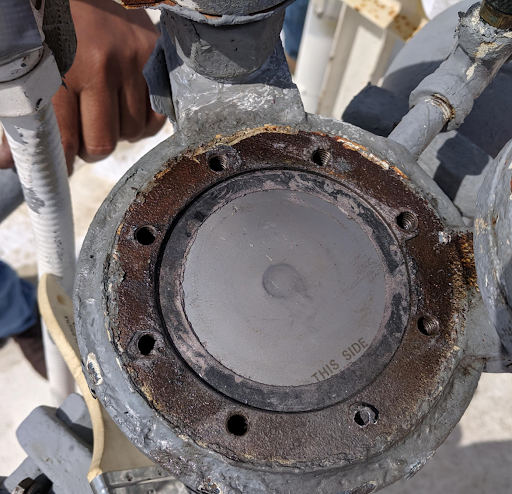Ammonia Release | Suction Regulator
Summary
In May 2019, ammonia began leaking from a suction regulator installed on the roof of a facility. The incident resulted in seven reported injuries and one fatality. The leak calculations determined that approximately 12 lbs of ammonia was released before the valve was isolated.
Incident Description
One of the eight bolts holding the suction regulator gasket broke. This caused a slit to open on the side of the gasket which allowed pressurized ammonia to escape. Facility employees smelled the ammonia and began to evacuate. When an ammonia contractor arrived on the scene, the King Valve was closed, and the leaking suction regulator was isolated and purged of residual ammonia.
The cause of the incident was determined to be an equipment malfunction of the suction regulator. The internal components of the valve had been inspected two months prior to the incident. Therefore, it is unlikely that inadequate maintenance is a contributing factor.
One of the employees was admitted to the hospital and later passed away. The employee was not directly exposed to the ammonia, but had an underlying heart condition that was exacerbated by the event.
Release Calculation
The opening in the valve where the ammonia leak occurred was measured to be approximately ¾” wide by 1/64” high. Using the calculation basis from Dow’s Chemical Exposure Index Guide, First Edition, the amount of ammonia released in the 25 minute span was calculated to be approximately 12 lbs. This was based on the following criteria:
- Molecular Weight of Ammonia: 17.03 g/mol
- Temperature of Ammonia: 17℉
- Area of the Hole: 0.012 in²
- Length of Release: 25 minutes
Significance
Even when maintenance tasks are performed at the proper frequency, mechanical failures can, and do happen. Fortunately, the mechanical failure occurred on the low pressure side of the system where the amount of ammonia released was minimal.
It should be noted that even a small ammonia release was enough to be noticeable to the employees and initiate an evacuation. Facilities may wish to consider that panic often arises when an employee outside the realm of refrigeration smells ammonia. Excessive panic or slight ammonia exposure could be fatal to those with underlying health conditions. Thorough and frequent ammonia awareness training may help to put employees at ease, and ensure they are well-prepared when an evacuation is necessary.



Leave a Reply